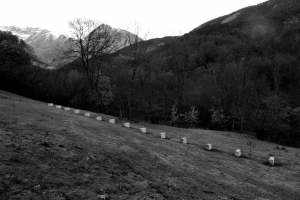Owen Parent
Art Report
Sculpture 2
Prof. Meiser
Richard Nonas, The Raw Edge
Immediate Responses:
The first time I looked at this piece, it seemed militaristic. I imagined the blocks of stone lining the mountains as soldiers marching to battle. The art seems abrasive and intentionally out-of-place in the rolling hills and mountains. The sharp edges and meticulous spacing of the limestone blocks aren’t natural at all, and the piece’s overall presence is something that is hard to pull your eyes away from. My eyes were immediately drawn to how the piece interacts with its surroundings because the intentionality of the blocks is in such stark contrast with the woods and mountains. Another thing that I noticed was the simplicity of what the piece was, at its core, it is several lines of stones in a field.
Objective Description:
The Raw Edge (2012) is an installation in Viere, Haut Provence, France by Richard Nonas (pictured above). In the piece, 140 blocks of Luberon limestone, each measuring 45x60x20 cm, are arranged in three locations. At the Viere location, the blocks are aligned in two lines that meet at a right angle in the corner of a field. The blocks are arranged in perfectly straight lines and are spaced evenly at distances of about two meters. The piece is nestled in a field amongst snowcapped mountains and thickly wooded forest. The Raw Edge, much like all sculptures and pieces of installation art, changes as the perspective of the viewer changes.
Technical Decisions:
The material choice in The Raw Edge shows the connection between the artwork and its surroundings. The blocks are made of Luberon limestone, which comes from the Luberon mountain range in southeastern France. This means that the artwork is actually made out of the same material that the surrounding mountains are made out of. The lines in this piece allow the eyes to move incrementally along each repeated block of limestone. The most interesting thing about the lines related to eye movement in this piece is that it does not only have to be eye movements, viewers can actually move through and around the art.
The Work in the World:
In a statement about the piece, Nonas referred to the Nazca Lines in South America, Egyptian Obelisks and Australian Dreamlines as some of the most “direct, simple and immediate marking of human thought onto complex and natural reality.” In some ways, Nonas is emulating these ancient cultural, religious, and artistic works through The Raw Edge. He appreciates the simplicity of straight lines installed in nature by humans because it is a reference to ancient methods of claiming land and honoring the deceased.
The Story it Tells:
After looking into this piece of art more deeply for a period of time, my impressions completely changed from what they were when I first saw it. Initially, I saw the work as abrasive and out of place, however now I see that this piece is heavily inspired by the history of many civilizations across the world. The primitive methods used to create the blocks could have been used thousands of years ago just like some of the world’s early civilizations did. The title of the piece speaks to its almost primitive and “raw” nature, and even though it is raw, the precision with which it is constructed and aligned is elegant.
